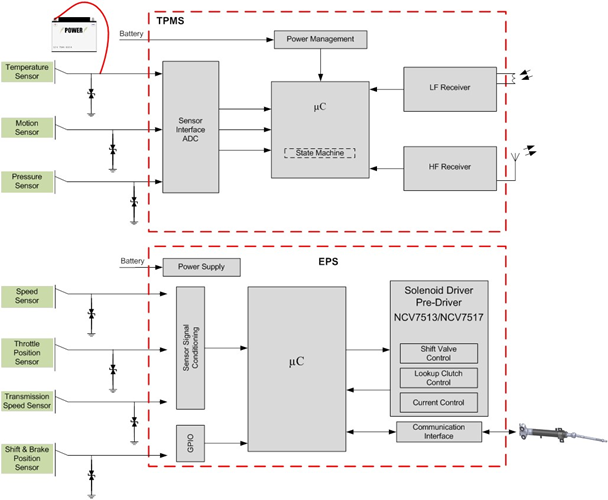Most silicon ESD protection solutions on the market today are designed for consumer electronics, but ESD threats can also keep automotive electronics designers up at night. It’s not just “normal” ESD conditions that worry automotive electronics designers, other automotive-specific events are also a major cause of sleeplessness, such as short-to-battery (STB) conditions.
Automotive battery short circuits can occur during assembly, repair, or when the devices are used by consumers in their cars. During assembly and repair, disconnected or exposed battery wires can be connected to any interface, which can damage the ESD protection device. A typical example of a battery short circuit during consumer use is a USB cable dropped into the car cigarette lighter socket, bringing the battery line voltage into the interface line. The presence of a 12V battery network in the automotive environment itself puts an additional burden on the automotive ESD protection devices, as these devices need to deal with situations where someone intentionally or accidentally shorts these interfaces with the battery wires. Therefore, if the interface is subject to this battery short circuit condition in addition to the ESD threat, the 5V conventional breakdown ESD devices used primarily in consumer electronics are not suitable.
The automotive-grade ESD protection device developed by ON Semiconductor takes into account the stand-off voltage and current limiting capabilities, and can easily deal with battery short circuit and ground short circuit (STG) events. In addition to these features, the device can also meet the needs of high-speed ESD protection, such as low insertion loss, high bandwidth and ultra-low capacitance, which are critical to signal integrity.

ESD protection devices such as the SZESD7361 , SZESD7462 , SZESD7102 , and SZESD1L001 have a minimum breakdown voltage of 16 V and can withstand automotive battery short-circuit conditions with battery voltages as low as 9 V and as high as 16 V. These devices not only provide low clamping ESD protection, but also have ultra-low capacitance and can operate in the GHz frequency range.
Devices such as the NIV1161 and NIV2161 have the same ESD protection silicon as the previous devices, while integrating small signal MOSFETs for current limiting, providing short-to-battery and short-to-ground protection for SoCs. These integrated MOSFETs have low Rds(on) and are suitable for applications with high data rates of Gigabits per second.
Previous article:Elektrobit and NXP collaborate to launch new platform for highly automated driving systems
Next article:Four technology trends that improve the driving experience
- Popular Resources
- Popular amplifiers
- A new chapter in Great Wall Motors R&D: solid-state battery technology leads the future
- Naxin Micro provides full-scenario GaN driver IC solutions
- Interpreting Huawei’s new solid-state battery patent, will it challenge CATL in 2030?
- Are pure electric/plug-in hybrid vehicles going crazy? A Chinese company has launched the world's first -40℃ dischargeable hybrid battery that is not afraid of cold
- How much do you know about intelligent driving domain control: low-end and mid-end models are accelerating their introduction, with integrated driving and parking solutions accounting for the majority
- Foresight Launches Six Advanced Stereo Sensor Suite to Revolutionize Industrial and Automotive 3D Perception
- OPTIMA launches new ORANGETOP QH6 lithium battery to adapt to extreme temperature conditions
- Allegro MicroSystems Introduces Advanced Magnetic and Inductive Position Sensing Solutions
- TDK launches second generation 6-axis IMU for automotive safety applications
- LED chemical incompatibility test to see which chemicals LEDs can be used with
- Application of ARM9 hardware coprocessor on WinCE embedded motherboard
- What are the key points for selecting rotor flowmeter?
- LM317 high power charger circuit
- A brief analysis of Embest's application and development of embedded medical devices
- Single-phase RC protection circuit
- stm32 PVD programmable voltage monitor
- Introduction and measurement of edge trigger and level trigger of 51 single chip microcomputer
- Improved design of Linux system software shell protection technology
- What to do if the ABB robot protection device stops
- Huawei's Strategic Department Director Gai Gang: The cumulative installed base of open source Euler operating system exceeds 10 million sets
- Download from the Internet--ARM Getting Started Notes
- Learn ARM development(22)
- Learn ARM development(21)
- Learn ARM development(20)
- Learn ARM development(19)
- Learn ARM development(14)
- Learn ARM development(15)
- Analysis of the application of several common contact parts in high-voltage connectors of new energy vehicles
- Wiring harness durability test and contact voltage drop test method
- Question about capacitors
- CC1310 Direct Operation Register Programming
- Practical RF training course sharing 3
- E2PROM maximum capacity
- A simple "video player" based on 51 single chip microcomputer
- Taiwan Sun Yat-sen University ASIC Laboratory Comprehensive Script Tutorial
- How can I find out the maximum output power of a DCDC buck chip from its technical documentation?
- The ESP32 branch of MicroPython now has dual cores enabled by default
- Vehicle CAN bus network data access and research significance
- Watch the HDC 2022 developer keynote speech, and a demo will explain the Hongmeng development kit

 LH2101AD
LH2101AD
















 京公网安备 11010802033920号
京公网安备 11010802033920号